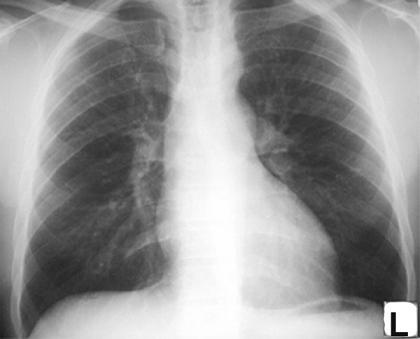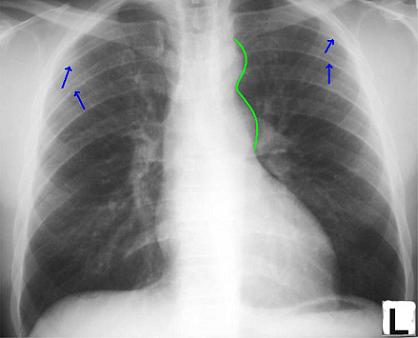WBR0043
| Author | PageAuthor::Gonzalo Romero (Reviewed by Will Gibson) |
|---|---|
| Exam Type | ExamType::USMLE Step 1 |
| Main Category | MainCategory::Embryology |
| Sub Category | SubCategory::Cardiology |
| Prompt | [[Prompt::A 17-year-old male is brought to his pediatrician by his father for severe headache and nosebleeds over the last six months. He complains that his feet become very cold at night for which he has been wearing two pairs of thick socks. At school he gets occasional cramps in his legs and is easily winded when running in gym class. He denies using any drugs or drinking alcohol. His grades are stable and he has a girlfriend, but is not sexually active. On physical exam his vitals are
Respiratory Rate:15 Blood Pressure: 170/95 on the upper extremities and 100/70 in the lower extremities. His neck is supple without lymphadenopathy. He has clear breath sounds bilaterally, but a continuous murmur is heard over the inter-scapular area. A chest x-ray is ordered and is shown below.  Which of the following is the most specific radiographic finding for the patient's condition?]] |
| Answer A | AnswerA::Kerley B lines |
| Answer A Explanation | [[AnswerAExp::Kerley lines are short parallel lines at the lung periphery. These lines represent distended interlobular septa, which are usually less than 1 cm in length and parallel to one another at right angles to the pleura. They are located peripherally in contact with the pleura, but are generally absent along fissural surfaces. They may be seen in any zone but are most frequently observed at the lung bases at the costophrenic angles on the PA radiograph, and in the substernal region on lateral radiographs. These lines are present when interstitial edema is present, therefore not being specific for aortic coarctation.]] |
| Answer B | AnswerB::Ribs notching |
| Answer B Explanation | [[AnswerBExp::The following are radiologic findings in aortic coarctation:
|
| Answer C | AnswerC::Cardiomegaly |
| Answer C Explanation | [[AnswerCExp::Cardiomegaly causes There are many causes of cardiomegaly, including medications, genetic conditions, endocrine conditions, infectious processes, toxins and iatrogenic causes. Therefore is not a specific radiologic finding.]] |
| Answer D | AnswerD::Pleural effusion |
| Answer D Explanation | [[AnswerDExp::Pleural effusion The most common causes of transudative pleural effusions in the United States are left ventricular failure, pulmonary embolism, and cirrhosis (causing hepatic hydrothorax), while the most common causes of exudative pleural effusions are bacterial pneumonia, cancer (with lung cancer, breast cancer, and lymphoma causing approximately 75% of all malignant pleural effusions), viral infection, and pulmonary embolism. Therefore pleural effusion is not specific for aortic coarctation.]] |
| Answer E | AnswerE::Patchy alveolar infiltrates |
| Answer E Explanation | [[AnswerEExp::Cardiogenic pulmonary edema can be distinguished from noncardiogenic pulmonary edema by the presence of redistribution of blood flow to the upper lobes (increased blood flow to the higher parts of the lung) and interstitial edema. In contrast, patchy alveolar infiltrates with air bronchograms are more indicative of noncardiogenic edema, therefore not being specific for aortic coarctation. [[1]]]] |
| Right Answer | RightAnswer::B |
| Explanation | [[Explanation::This teenager is presenting with symptoms of post-ductal aortic stenosis, which is a localized narrowing or abrupt constriction of the Aortic arch after the ligamentum arteriosum. It may be associated with a bicuspid aortic valve. It is more common in males than females with a ratio of 2:1. Clinically the patient has headaches, epistaxis, dizziness, syncope, dyspnea, chest pain, cold feet or legs, leg cramps with exercise, differential hypertension, poor growth and decreased exercise performance. There are 3 potential sources of a murmur: multiple arterial collaterals (continuous murmur), an associated bicuspid aortic valve (systolic ejection click) and the coarctation itself, which can be heard over the left infraclavicular area and under scapula. The chest X ray shows irregular notching of the inferior margins of the posterior ribs resulting from collateral flow through dilated and pulsatile intercostal arteries. Aortic coarctation
 Educational Objective: Aortic coarctation can produce specific signs on chest x-ray such as: irregularities or notching of the inferior margins of the posterior ribs, an inverted "3" sign of the barium-filled esophagus References: First Aid 2014 page 283 |
| Approved | Approved::Yes |
| Keyword | WBRKeyword::WJG |
| Linked Question | Linked:: |
| Order in Linked Questions | LinkedOrder:: |
Image [[WBRImage::|]] Caption WBRImageCaption::no-display Position [[WBRImagePlace::|]]